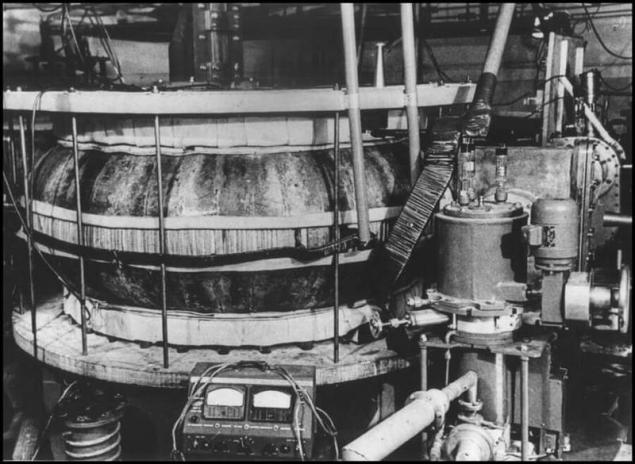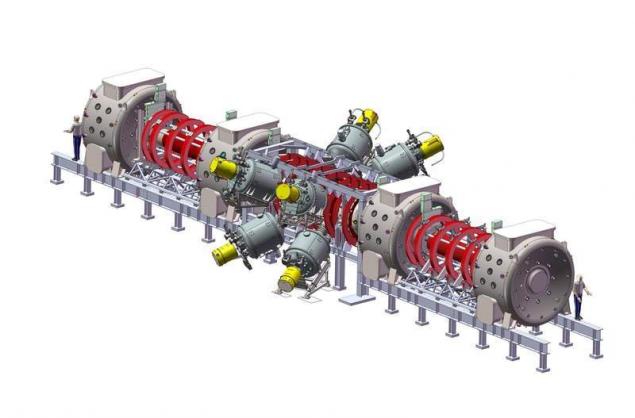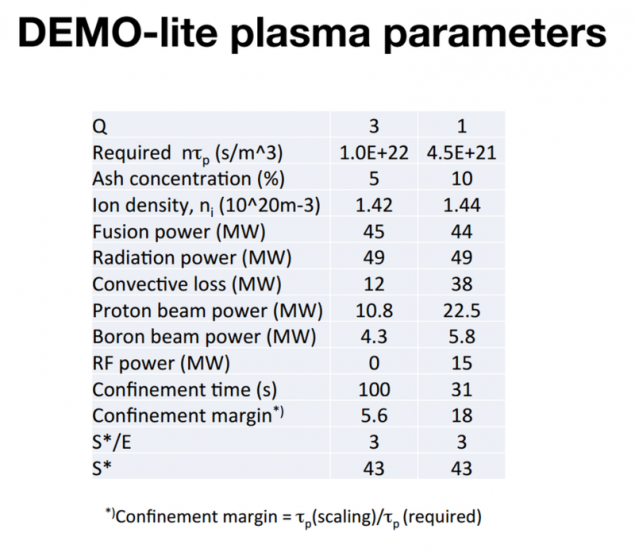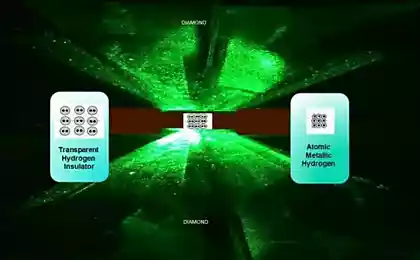732
Clean energy for pennies
When will fusion power? Scientists often say something like “in 20 years we will solve all questions of principle”. Engineers from the nuclear industry say about the second half of the 21st century. Politicians talk about the sea of pure energy for a penny, not bothering to date. Economists say never.
People tend to make predictions, extrapolating from existing experience. In the case of attempts to create commercial fusion power plants experience negative 60 years efforts have led to partial success — something there, but it's obviously not something that you can use every day to generate electricity. Intuition says that if in 60 years we have not overcome this wall, then in the future something good can be expected.

The creators of the world's first tokamak, T-1 Artsimovich, Yavlinsky also promised power plant in 20 years.
And for good reason. Because the amount of technology and knowledge continuously growing, including the plasma and its confinement. At some point our knowledge will be enough in ordinary and routine investments in technology development, without special feats, fusion energy became possible.

Here, for example, routine sample work on the installation of C-2U company Tri Alpha Energy
On the way to this “possible” today to a large extent are psychological barriers. Too often the developers of fusion reactors are faced with unpredictability, over-rated, a new unpleasant facts from plasma physics. Too often the way of dealing with these facts the plant concept in economic deadlock, when a simple initially the car was pricecialis two dozen miracles of engineering, and the resulting installation itself is a record breaking solution in which there was no place left for “easy operation”, “reliability”, “low cost”.

Luxury new poster with a cutaway of ITER hints at the depth of the ass problems with the complexity of fusion devices.
Against this background, it is very difficult to take responsibility for solving future, unknown problems, and postulate that a fusion reactor can be built, even if the physics and engineering first light is a green light. What if the growth in the size of the reactor will open a new unpleasant type of instability? What if the economy yesterday's brilliant engineering discoveries that make the reactor to be below the floor? What if the materials of fusion reactor by increasing the length from 10 seconds up to 31000000 will not survive?

Official plans for Europe, even in a very optimistic view of the promise prototype fusion power plant by 2050. Is it possible that someone will do it sooner?
Today, the construction of fusion power plants is psychologically closest is a California company Tri Alpha Energy (TAE). Here a team of 150 people, including many eminent physicists plasmatv put in conditions when they need every 2-3 years to show the new achievement in the General outline of the movement towards a commercial fusion power plant. In fact, they put the plan on the discoveries in the field of plasma physics. The downside of this pressure is the crazy pace of implementation of ideas of scientists — their big experimental setup Tri Alpha easy upgrade for a month after the appearance of new ideas — compare with years for University and academic units.
SUBSCRIBE to OUR youtube channel that allows you to watch online, download from YouTube free video about the recovery, the rejuvenation of man. Love for others and ourselves, as the feeling of high vibrations — an important factor for improvement .
Interesting video from TAE — restoration picture of what is happening with the plasma in the installation of C-2U. Note the timer at the top left — it becomes clear that to hold the plasma without decay 8000 microseconds (current record) — it's pretty long.
The idea underlying the reactor TAE — use plasma vortices (called FRC — Field Reversed Configuration), which have the property of self-holding and some more benefits, maintaining their stability using neutral beam injectors, quite fresh — a native of the mid 90. Anyway, it is newer than the idea of the tokamak, the stellarator, or the classic open traps. FRC have a fairly unusual set of properties that such a reactor is convenient to use a fusion reaction H1 + B11 = 3*He4 (here H1 — the usual hydrogen, B11 is the most common isotope of boron, and He4 — emitted alpha particles, hence the name of the company Three alpha). Ironic thing here is that this is one of the most difficult variants of thermonuclear reaction — it requires a temperature 15 times higher than the “classic” deuterium-tritium, and thus 15 times larger than the pressure of the magnetic field to hold and more stringent requirements on the purity of plasma.

The speed of different thermonuclear reactions at the same density depending on temperature. Please note that the left scale is logarithmic. At a temperature of 320 Kev, pB11 is nearly indistinguishable from DHe3 and only a few times slower than the classic DT.
However, the FRC allow you to use almost the entire amount of pressure on the magnetic field, in contrast to tokamaks, where you can only use 10%. Have pB11 advantages — both components are widely distributed and secure (unlike radioactive tritium and helium isotope He3, non-existent on Earth, and if the tritium can at least get from lithium, He3 — only to get somewhere in space), and the addition reaction gives high neutron radiation. For the reactor on the DT neutron radiation, carrying 86% of the energy of thermonuclear reactions is a real problem, quickly destroying and activating structural materials. For pB11 power of neutrons is ~0.1% of reactor power through side reactions.

He so arranged schematically FRC plasma in an external longitudinal field whirls in the form of a cylinder and a private field holds of itself. This configuration is prone to collapse quickly, but the founder of TAE proposed the idea of how this education can be maintained, and the TAE team have proved its correctness.
Usually plasmati pay more attention to limiting the difficulty of obtaining plasma parameters needed for pB11 than the significant economic advantages of this reaction. Tritium and neutrons in a reactor is a tremendous burden to a multiple of the high cost and complicate the concept of the reactor, however, to deal with these difficulties already are not physicists. On the other hand the variant on the reaction D + He3 — almost too anachrony (power neutron — 1-4% of reactor power) suffers from the need to parallel power to build and infrastructure for the extraction гелия3 today malpractive lesson (for example, it is possible to obtain in the atmosphere of Uranus, how about this? Although someone will be unhappy that in the end we do not deliver fuel with Uranium).

For investors TAE is already drawing pre-image of a thermonuclear reactor with a capacity of 380 megawatts (electric). Plans to build fifty such power plants in 2030h years
Hydrogen and Boron-11 is more accessible than the fuel of nuclear power — uranium 235 or plutonium 239.
Tri Alpha, collecting the experts level of the best world centers for the study of fusion plasma, moves very quickly. In 2015, it was shown that FRC vortices ways to support, not decaying, with powerful tangential beams of neutral particles is one of the key claims of the founder of physics Norman Rostoker. And they build a new installation that must be achieved 30-fold increase in the triple parameter (the product of density, temperature and confinement time — the key properties that determine energovod a thermonuclear reaction plasma. If TAE will again have to wait for success, then this setting will allow you to find the so-called scaling — empirical dependence of the triple option from the characteristics of the installation (size, magnetic field, power injectors neutrals, etc.). And scaling, in turn, will allow high accuracy to determine whether you can really make the reactor on the basis of the idea of Tri Alpha, or it will be unattainable.

Car collected now TAE — C2W, will be equipped with 8 injectors neutral beam INP, and is able to hold a FRC with a temperature of 1-3 Kev and thermonuclear density within ~30 milliseconds, the ability to work with hydrogen, deuterium and boron plasma.

And this is far plans, the final installation of the line, since the fusion output. Q here is one of the most challenging pB11 parameters — the ratio of fusion output to warm up.
Interestingly, the way nature sometimes throws up not only challenges, but also gifts. For example, in all textbooks it is written that nuclear fusion of hydrogen-boron (p + B11 -> He4+He4+He4) in optically transparent plasma will always lose more energy than to extract, ie to maintain the desired external heating — the path to the ideal case and quite small ~15% of the power of a nuclear reactor. This unpleasant feature of pB11 is fairly easy to calculate from the cross section (probability) of the reaction at collision of a proton and a boron ion and the calculation of electromagnetic losses by scattering of hot electrons (a pB11 requires 20 times more temperature than Tarovskaya reaction D+T → He + n). Now, a new, more accurate measurement of the cross section for the reaction pB11 showed that the cross section is higher than previously thought. At certain temperatures, according to new data fusion in this reaction gives off more energy than is lost! Interesting to see how rewriting physics textbooks.

The new values of the cross sections of the reaction pB11 depending on the temperature (red).

And have an amazing time when we need to rewrite the physics textbooks — if before (blue dotted line) energovod reactions were lower losses (red line) even in a theoretical option, it is now approximately equal (blue line), and even a little more.
However, the distance that must be overcome Tri Alpha is still very large, even if the scalings are accurate, need to improve retention in the hundreds of times the pressure of the magnetic field, power and time NBI and all other systems. Team TAE may be faced with a typical problem of thermonuclear installations — they become too big, complex, and moving too slowly on the way to commercial reactors. Turning to the figures, I must say that now record the temperature of the FRC is less than one thousand eV, and you need 320 000 eV. While the energy retention of a few milliseconds, and need tens of seconds. The density is also at least ten times does not reach the parameters needed in an industrial setting. Part of this can be overcome just by increasing the size and capacity of the reactor, but part of the need to increase the quality and improving the purity of the plasma, the efficiency of support systems, finding new, more successful, operation modes of the plasma.

Another work of the artist on the theme of the possible shape of future machines TAE.

The picture with asterisk different options the first fusion machine Tri Alpha with the confinement better and worse. The retention time of the FRC from 7 to 30 seconds (not milliseconds!), need system power FRC with fuel, the pumping of helium ash, which clogs the furnace", the new megavolt injectors neutral beam, now being developed in Novosibirsk INP and bit of luck that the plasma is not thrown out the next trick.
Tri Alpha is planning to pass this way (before a prototype power plant) 5 plants and 15 years, and received from a variety of investors for this job about half a billion dollars.

The photo inside had been stripped installation C-2U. By the way, the employee was dressed, not in order that everybody would understand his greatness, and that would not leave organic matter on the inner walls of the chamber the plasma is extremely sensitive to the quality of the vacuum and the dirt, and a single hair in the vacuum chamber may not give to experiment.
But as I said before about the psychology. While the team TAE confidently eats the eyes of investors, other experts have repeatedly burned on forecasts of modest speak about the prospects of fusion energy. However, the latest theoretical ideas in Nuclear Physics Institute. Budker in Novosibirsk, if they are confirmed in the experiment can be great to simplify the creation of thermonuclear reactor, multiple reducing its size and complexity.
Before I talk about them, I would like to stop at interesting moment. Imagine that you many decades of fusion physicists give money under the firm plans power plant in 20 years, and every time they come in and say “plasma was more difficult than we thought, we need another 20 years.” And then they come and say “plasma was more difficult than we thought, so we have a simple and cheap solution, but we need 20 years.” What will you say?
So, we are talking about the two as a theoretical possible ideas — “diamagnetic bubble” and “plasma pumped by a helical magnetic field”. The first is that would open the trap to inflate the “bubble” of plasma, thereby essentially increasing the amount of plasma and its pressure — perfect direction if we want to reduce energy loss from fusion plasmas. Seemingly trivial idea includes a few clever features, the understanding of which appeared in the last decade. Such bubble is capable of in ~10 times smaller fusion reactor on an open trap. Experimental verification of this idea is expected in the next couple of years.

The bubble is really a bubble. The original contour of the plasma in the trap type GDL-drawn blue line.

A schematic sectional view of the open trap of GDL, which had the idea of a "bubble", and which applies a significant size reduction of a power reactor, if this idea will work.
Since we're talking about the open trap — let me remind you that this is the simplest variant of the thermonuclear didn't at the time because of two main problems — instabilities, which have learned to fight in the 21st century, when interest in the traps was mostly lost and a large longitudinal conduction (i.e., leakage of heat from the plasma via the holes in the end of the cylindrical installation on it and open trap). The second problem is not solved until the end of today, so instead of deuterium or boron have to burn coal. So, the “plasma pumping helical magnetic field” is a type of the magnetic system, which is installed on the open ends of the trap and pumps the plasma back due to the interaction of helical magnetic field rotating around the axis of the plasma flying out. Efficiency in the suppression of longitudinal heat conduction in such systems can be incredibly high, deciding the remaining fundamental problem of the OL.

Schematic diagram of the plant RESIN on the left plasma cannon, in the middle of the spiral magnetic system, tank to the left-dilator with segmented electron, which creates an electric gradient in the plasma which it spins. Screw system can be switched "along" and "against" plasma.
Most interesting is that the setting RESIN to check “screw retention” is going to INP, and may in the spring of 2017 will see the first results. Once again — 50 years this problem has not been given to take and build a fusion reactor based on open traps (in fairness, along with other physical issues and a lot more waiting ahead of engineering), and can be closed in a fairly routine physical experiment next year.

Article in 1958 about the "Stellarator, which promises a significant leap in obtaining useful power from controlled thermonuclear fusion".
Also I wonder Why there is still no batteries for the new generation?
Russia will to develop alternative energy in the Arctic
Summing up, I again will remember about psychology. People last 30 years get used to the idea that nuclear energy, at least not economically justified, and perhaps expressly prohibited in engineering or physical reasons. Was used in an era when the success of physicists in this way was incomplete, and the proposed design of fusion reactors viable. Perhaps now we are entering the next era, when we have to forget the fact that fusion power is impossible. When rejected the idea of 40 or even 60 years ago with a new understanding of the plasma and technical capabilities (e.g., superconductors or digital control systems) suddenly lit the green light.published
Author: Valentin @tnenergy
P. S. And remember, only by changing their consumption — together we change the world! ©
Source: geektimes.ru/post/279868/
People tend to make predictions, extrapolating from existing experience. In the case of attempts to create commercial fusion power plants experience negative 60 years efforts have led to partial success — something there, but it's obviously not something that you can use every day to generate electricity. Intuition says that if in 60 years we have not overcome this wall, then in the future something good can be expected.

The creators of the world's first tokamak, T-1 Artsimovich, Yavlinsky also promised power plant in 20 years.
And for good reason. Because the amount of technology and knowledge continuously growing, including the plasma and its confinement. At some point our knowledge will be enough in ordinary and routine investments in technology development, without special feats, fusion energy became possible.

Here, for example, routine sample work on the installation of C-2U company Tri Alpha Energy
On the way to this “possible” today to a large extent are psychological barriers. Too often the developers of fusion reactors are faced with unpredictability, over-rated, a new unpleasant facts from plasma physics. Too often the way of dealing with these facts the plant concept in economic deadlock, when a simple initially the car was pricecialis two dozen miracles of engineering, and the resulting installation itself is a record breaking solution in which there was no place left for “easy operation”, “reliability”, “low cost”.

Luxury new poster with a cutaway of ITER hints at the depth of the ass problems with the complexity of fusion devices.
Against this background, it is very difficult to take responsibility for solving future, unknown problems, and postulate that a fusion reactor can be built, even if the physics and engineering first light is a green light. What if the growth in the size of the reactor will open a new unpleasant type of instability? What if the economy yesterday's brilliant engineering discoveries that make the reactor to be below the floor? What if the materials of fusion reactor by increasing the length from 10 seconds up to 31000000 will not survive?

Official plans for Europe, even in a very optimistic view of the promise prototype fusion power plant by 2050. Is it possible that someone will do it sooner?
Today, the construction of fusion power plants is psychologically closest is a California company Tri Alpha Energy (TAE). Here a team of 150 people, including many eminent physicists plasmatv put in conditions when they need every 2-3 years to show the new achievement in the General outline of the movement towards a commercial fusion power plant. In fact, they put the plan on the discoveries in the field of plasma physics. The downside of this pressure is the crazy pace of implementation of ideas of scientists — their big experimental setup Tri Alpha easy upgrade for a month after the appearance of new ideas — compare with years for University and academic units.
SUBSCRIBE to OUR youtube channel that allows you to watch online, download from YouTube free video about the recovery, the rejuvenation of man. Love for others and ourselves, as the feeling of high vibrations — an important factor for improvement .
Interesting video from TAE — restoration picture of what is happening with the plasma in the installation of C-2U. Note the timer at the top left — it becomes clear that to hold the plasma without decay 8000 microseconds (current record) — it's pretty long.
The idea underlying the reactor TAE — use plasma vortices (called FRC — Field Reversed Configuration), which have the property of self-holding and some more benefits, maintaining their stability using neutral beam injectors, quite fresh — a native of the mid 90. Anyway, it is newer than the idea of the tokamak, the stellarator, or the classic open traps. FRC have a fairly unusual set of properties that such a reactor is convenient to use a fusion reaction H1 + B11 = 3*He4 (here H1 — the usual hydrogen, B11 is the most common isotope of boron, and He4 — emitted alpha particles, hence the name of the company Three alpha). Ironic thing here is that this is one of the most difficult variants of thermonuclear reaction — it requires a temperature 15 times higher than the “classic” deuterium-tritium, and thus 15 times larger than the pressure of the magnetic field to hold and more stringent requirements on the purity of plasma.

The speed of different thermonuclear reactions at the same density depending on temperature. Please note that the left scale is logarithmic. At a temperature of 320 Kev, pB11 is nearly indistinguishable from DHe3 and only a few times slower than the classic DT.
However, the FRC allow you to use almost the entire amount of pressure on the magnetic field, in contrast to tokamaks, where you can only use 10%. Have pB11 advantages — both components are widely distributed and secure (unlike radioactive tritium and helium isotope He3, non-existent on Earth, and if the tritium can at least get from lithium, He3 — only to get somewhere in space), and the addition reaction gives high neutron radiation. For the reactor on the DT neutron radiation, carrying 86% of the energy of thermonuclear reactions is a real problem, quickly destroying and activating structural materials. For pB11 power of neutrons is ~0.1% of reactor power through side reactions.

He so arranged schematically FRC plasma in an external longitudinal field whirls in the form of a cylinder and a private field holds of itself. This configuration is prone to collapse quickly, but the founder of TAE proposed the idea of how this education can be maintained, and the TAE team have proved its correctness.
Usually plasmati pay more attention to limiting the difficulty of obtaining plasma parameters needed for pB11 than the significant economic advantages of this reaction. Tritium and neutrons in a reactor is a tremendous burden to a multiple of the high cost and complicate the concept of the reactor, however, to deal with these difficulties already are not physicists. On the other hand the variant on the reaction D + He3 — almost too anachrony (power neutron — 1-4% of reactor power) suffers from the need to parallel power to build and infrastructure for the extraction гелия3 today malpractive lesson (for example, it is possible to obtain in the atmosphere of Uranus, how about this? Although someone will be unhappy that in the end we do not deliver fuel with Uranium).

For investors TAE is already drawing pre-image of a thermonuclear reactor with a capacity of 380 megawatts (electric). Plans to build fifty such power plants in 2030h years
Hydrogen and Boron-11 is more accessible than the fuel of nuclear power — uranium 235 or plutonium 239.
Tri Alpha, collecting the experts level of the best world centers for the study of fusion plasma, moves very quickly. In 2015, it was shown that FRC vortices ways to support, not decaying, with powerful tangential beams of neutral particles is one of the key claims of the founder of physics Norman Rostoker. And they build a new installation that must be achieved 30-fold increase in the triple parameter (the product of density, temperature and confinement time — the key properties that determine energovod a thermonuclear reaction plasma. If TAE will again have to wait for success, then this setting will allow you to find the so-called scaling — empirical dependence of the triple option from the characteristics of the installation (size, magnetic field, power injectors neutrals, etc.). And scaling, in turn, will allow high accuracy to determine whether you can really make the reactor on the basis of the idea of Tri Alpha, or it will be unattainable.

Car collected now TAE — C2W, will be equipped with 8 injectors neutral beam INP, and is able to hold a FRC with a temperature of 1-3 Kev and thermonuclear density within ~30 milliseconds, the ability to work with hydrogen, deuterium and boron plasma.

And this is far plans, the final installation of the line, since the fusion output. Q here is one of the most challenging pB11 parameters — the ratio of fusion output to warm up.
Interestingly, the way nature sometimes throws up not only challenges, but also gifts. For example, in all textbooks it is written that nuclear fusion of hydrogen-boron (p + B11 -> He4+He4+He4) in optically transparent plasma will always lose more energy than to extract, ie to maintain the desired external heating — the path to the ideal case and quite small ~15% of the power of a nuclear reactor. This unpleasant feature of pB11 is fairly easy to calculate from the cross section (probability) of the reaction at collision of a proton and a boron ion and the calculation of electromagnetic losses by scattering of hot electrons (a pB11 requires 20 times more temperature than Tarovskaya reaction D+T → He + n). Now, a new, more accurate measurement of the cross section for the reaction pB11 showed that the cross section is higher than previously thought. At certain temperatures, according to new data fusion in this reaction gives off more energy than is lost! Interesting to see how rewriting physics textbooks.

The new values of the cross sections of the reaction pB11 depending on the temperature (red).

And have an amazing time when we need to rewrite the physics textbooks — if before (blue dotted line) energovod reactions were lower losses (red line) even in a theoretical option, it is now approximately equal (blue line), and even a little more.
However, the distance that must be overcome Tri Alpha is still very large, even if the scalings are accurate, need to improve retention in the hundreds of times the pressure of the magnetic field, power and time NBI and all other systems. Team TAE may be faced with a typical problem of thermonuclear installations — they become too big, complex, and moving too slowly on the way to commercial reactors. Turning to the figures, I must say that now record the temperature of the FRC is less than one thousand eV, and you need 320 000 eV. While the energy retention of a few milliseconds, and need tens of seconds. The density is also at least ten times does not reach the parameters needed in an industrial setting. Part of this can be overcome just by increasing the size and capacity of the reactor, but part of the need to increase the quality and improving the purity of the plasma, the efficiency of support systems, finding new, more successful, operation modes of the plasma.

Another work of the artist on the theme of the possible shape of future machines TAE.

The picture with asterisk different options the first fusion machine Tri Alpha with the confinement better and worse. The retention time of the FRC from 7 to 30 seconds (not milliseconds!), need system power FRC with fuel, the pumping of helium ash, which clogs the furnace", the new megavolt injectors neutral beam, now being developed in Novosibirsk INP and bit of luck that the plasma is not thrown out the next trick.
Tri Alpha is planning to pass this way (before a prototype power plant) 5 plants and 15 years, and received from a variety of investors for this job about half a billion dollars.

The photo inside had been stripped installation C-2U. By the way, the employee was dressed, not in order that everybody would understand his greatness, and that would not leave organic matter on the inner walls of the chamber the plasma is extremely sensitive to the quality of the vacuum and the dirt, and a single hair in the vacuum chamber may not give to experiment.
But as I said before about the psychology. While the team TAE confidently eats the eyes of investors, other experts have repeatedly burned on forecasts of modest speak about the prospects of fusion energy. However, the latest theoretical ideas in Nuclear Physics Institute. Budker in Novosibirsk, if they are confirmed in the experiment can be great to simplify the creation of thermonuclear reactor, multiple reducing its size and complexity.
Before I talk about them, I would like to stop at interesting moment. Imagine that you many decades of fusion physicists give money under the firm plans power plant in 20 years, and every time they come in and say “plasma was more difficult than we thought, we need another 20 years.” And then they come and say “plasma was more difficult than we thought, so we have a simple and cheap solution, but we need 20 years.” What will you say?
So, we are talking about the two as a theoretical possible ideas — “diamagnetic bubble” and “plasma pumped by a helical magnetic field”. The first is that would open the trap to inflate the “bubble” of plasma, thereby essentially increasing the amount of plasma and its pressure — perfect direction if we want to reduce energy loss from fusion plasmas. Seemingly trivial idea includes a few clever features, the understanding of which appeared in the last decade. Such bubble is capable of in ~10 times smaller fusion reactor on an open trap. Experimental verification of this idea is expected in the next couple of years.

The bubble is really a bubble. The original contour of the plasma in the trap type GDL-drawn blue line.

A schematic sectional view of the open trap of GDL, which had the idea of a "bubble", and which applies a significant size reduction of a power reactor, if this idea will work.
Since we're talking about the open trap — let me remind you that this is the simplest variant of the thermonuclear didn't at the time because of two main problems — instabilities, which have learned to fight in the 21st century, when interest in the traps was mostly lost and a large longitudinal conduction (i.e., leakage of heat from the plasma via the holes in the end of the cylindrical installation on it and open trap). The second problem is not solved until the end of today, so instead of deuterium or boron have to burn coal. So, the “plasma pumping helical magnetic field” is a type of the magnetic system, which is installed on the open ends of the trap and pumps the plasma back due to the interaction of helical magnetic field rotating around the axis of the plasma flying out. Efficiency in the suppression of longitudinal heat conduction in such systems can be incredibly high, deciding the remaining fundamental problem of the OL.

Schematic diagram of the plant RESIN on the left plasma cannon, in the middle of the spiral magnetic system, tank to the left-dilator with segmented electron, which creates an electric gradient in the plasma which it spins. Screw system can be switched "along" and "against" plasma.
Most interesting is that the setting RESIN to check “screw retention” is going to INP, and may in the spring of 2017 will see the first results. Once again — 50 years this problem has not been given to take and build a fusion reactor based on open traps (in fairness, along with other physical issues and a lot more waiting ahead of engineering), and can be closed in a fairly routine physical experiment next year.

Article in 1958 about the "Stellarator, which promises a significant leap in obtaining useful power from controlled thermonuclear fusion".
Also I wonder Why there is still no batteries for the new generation?
Russia will to develop alternative energy in the Arctic
Summing up, I again will remember about psychology. People last 30 years get used to the idea that nuclear energy, at least not economically justified, and perhaps expressly prohibited in engineering or physical reasons. Was used in an era when the success of physicists in this way was incomplete, and the proposed design of fusion reactors viable. Perhaps now we are entering the next era, when we have to forget the fact that fusion power is impossible. When rejected the idea of 40 or even 60 years ago with a new understanding of the plasma and technical capabilities (e.g., superconductors or digital control systems) suddenly lit the green light.published
Author: Valentin @tnenergy
P. S. And remember, only by changing their consumption — together we change the world! ©
Source: geektimes.ru/post/279868/
Choose ECO cosmetics: 8 organic products for skin care
Spectacular experiment Harvard medical school























